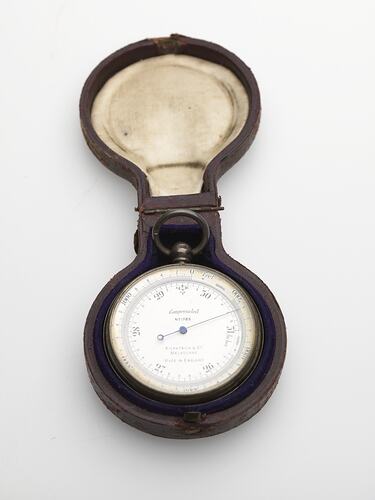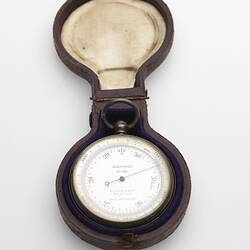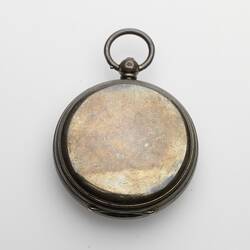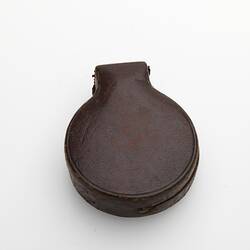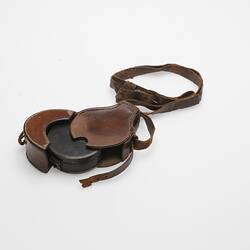Summary
Aneroid Barometer Type, Surveyor's Pocket Altimeter, branded Fitzpatrick & Co, Melbourne. Made in England. Serial number 1785. With leather carrying case.
This instrument was owned by William Calder, A.M.I.C.E., who was the founding chairman and chief engineer of the Country Roads Board of Victoria, from February 1913 until his death on 18 February 1928. Born in New Zealand in 1860, Calder had studied engineering at Otago University and gained accreditation as a surveyor in 1888, before emigrating to Victoria. In 1889, he was appointed as assistant town surveyor for the City of Footscray, becoming town engineer after gaining his certificate of municipal engineering the following year. In 1897, he was appointed as city engineer and building surveyor to the City of Prahran, where he experimented with the use of a variety of road surfaces and kept meticulous records on their relative cost of construction and maintenance, which gained him an Australia-wide reputation as something of an expert in road surfacing.
It is believed that this instrument was used by Calder for fieldwork during his early years with the C.R.B., during which period he and his two fellow board members, W.T.B. McCormack and F.W. Fricke, personally toured every municipality in the State, meeting with councillors and municipal engineers to gain insights into local traffic and road conditions and to explain the functions and powers of the C.R.B.. Travelling by motor car, horse dray and horseback they covered thousands of miles surveying the key roads in each district with a view to determining which routes should be declared 'Main Roads' under the authority of the Board, and deciding which sections were most in need of upgrade or urgent repair. Although these surveys were preliminary in nature, a pocket instrument such as this would have been invaluable for gaining a quick indication of the elevation and gradient of each section of road and for recording such information in their field notebooks.
The instrument measures elevation by sensing minute changes in barometric air pressure relative to a fixed datum point at sea level or a known elevation, such as the starting point of a major town during a road survey, and has an accuracy of +/- 20 feet when used in experienced hands. The label 'compensated' indicates that the instrument is constructed to compensate for the effect of temperature changes on the accuracy of readings.
Physical Description
Circular instrument of similar size and appearance to that of a medium sized pocket fob watch, with round sterling silver or silver plated case, glass cover over face with circular, and small reset button in the centre of a swivel knob at the top, to which is attached a 'bow' or ring at top for fixing to a fob chain or neck chain. The finely divided scale around the perimeter of the face is marked from 0 to 5000 feet elevation and 25.5 to 31 inches of mercury (Hg) for barometric pressure. The single fine counter-balanced hand or pointer rotates anti-clockwise with increasing elevation and decreasing pressure. The instrument has a dark red-brown hard leather carry case, with deep blue velveteen lining under the watch and a cream silk or satin lining on the underside of the lid. The case lid is hinged above the swivel knob and bow at the top of the instrument and has a press type spring catch at the bottom.
More Information
-
Collecting Areas
-
Acquisition Information
Donation from Mr Stuart W. Calder, 11 Feb 2013
-
Place & Date Made
London, England, Great Britain, circa 1900
The case is marked with hallmarks either side of the bow swivel, one of which appears to read 'CH' (possibly Charles Hill, of Russell Terrace, Chapel Fields, Coventry, England), and on the other side a Lion symbol representing 'sterling silver Made in England', and with the letter 'M' representing the year of manufacture - possibly 1901? -
Importer
Fitzpatrick & Co., Melbourne, Greater Melbourne, Victoria, Australia, circa 1895-1910
-
Past Owner
Mr William Calder M.Inst.C.E. - Country Roads Board of Victoria, by 1913 - 1928
-
Place Used
-
Inscriptions
Inscribed on face: 'Compensated / No.1785 / FITZPATRICK & Co / MELBOURNE / MADE IN ENGLAND' Haulmarks stamped on front and back of swivel at top are '[CH]' '[Lion image]' '[M]' The double scale around the perimeter of the face is marked with the outer ring in 'Feet' running from 0 to 5000 in a counterclockwise direction, labelled at each 1000, with minor divisions for each 20 feet, major divisions each hundred feet and even numbered hundreds marked with a single digit, such as '2' for 200. There is a feathered arrow pointing counterclockwise towards the zero at the top of the dial (or 12 o'clock position). The inner scale ring is marked in inches of Hg (labelled just 'Inches') from 25.5. to 31 inches, starting at about 4000 feet on the outer scale (or around the 4 o'clock position) labelled at each inch, with minor scale divisions at each 0.02 inch, and major scale divisions at each 0.1 inch. This scale is labelled with a single digit at each even tenth, such as '6' for 25.6. There is a feathered arrow pointing clockwise towards the start of the pressure scale at 25.5 inches and a scrolled arrow head at 29.5 inches in the 12 o'clock position.
-
Classification
-
Category
-
Discipline
-
Type of item
-
Overall Dimensions - Closed
76 mm (Length), 62 mm (Width), 26 mm (Depth)
External case dimensions with lid closed.
-
Overall Dimensions
49 mm (Width), 16 mm (Depth), 71 mm (Height), 49 mm (Outside Diameter)
Dimensions of instrument without case.
-
Keywords
Altimeters, Barometers, Road Construction, Surveying, Surveying Instruments
